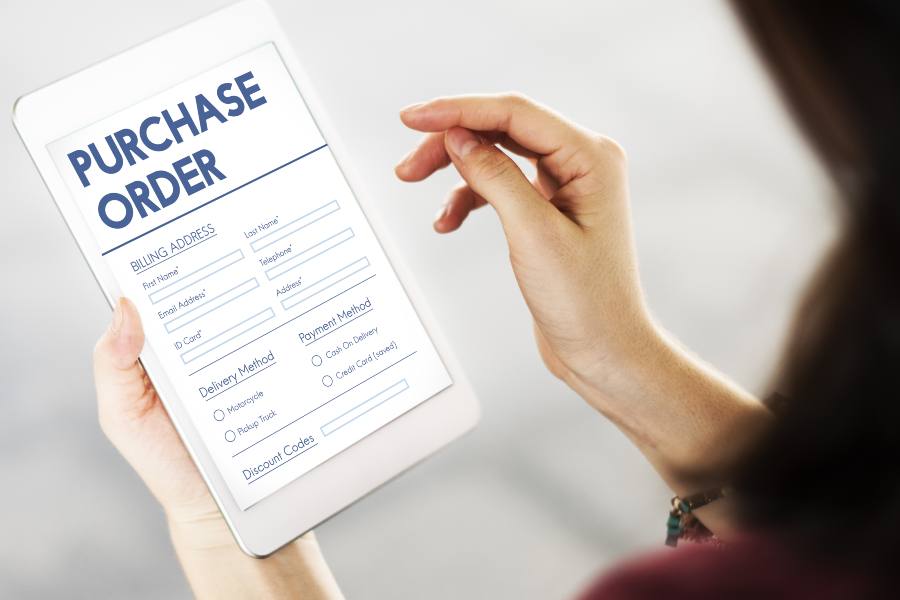A blanket purchase order (BPO) is a type of purchasing agreement between a buyer and supplier that establishes terms and conditions for multiple transactions over a specified period—typically a year. It provides flexibility to the buyer to order varying quantities of goods or services within the agreed-upon terms without the need to renegotiate for each transaction.
Consolidating purchases under a BPO can often lead to cost savings through bulk purchasing, volume discounts, and improved supplier relationships. BPOs are commonly used for frequently purchased office supplies, maintenance services, or utilities.
Key Takeaways
- While a BPO typically creates a legally binding agreement, clauses within the BPO can address when and how adjustments to the original agreement can be made.
- Instead of creating individual POs for each transaction, the buyer issues “releases” against the blanket order as goods or services are needed. These releases specify the quantity, delivery date, and other relevant details for each purchase.
- The terms and conditions of the BPO—such as pricing, delivery schedules, payment terms, quality standards, and any discounts or incentives—are prenegotiated and documented in the agreement.
- Unlike a standard PO, which is used for a one-time purchase of goods or services, a BPO allows the buyer to make multiple purchases from the supplier without creating separate POs each time.
Blanket Purchase Order Example
Let’s consider an example of a BPO scenario to illustrate how it works.
Scenario: ABC Company, a manufacturing firm, regularly purchases raw materials from XYZ Supplier to support its production activities. Instead of creating separate POs for each batch of raw materials, ABC Company decides to establish a BPO with XYZ Supplier to streamline the procurement process.
Key Details of the Blanket Purchase Order:
- Supplier: XYZ Supplier
- Buyer: ABC Company
- Duration: One year (Jan. 1, 2024, to Dec. 31, 2024)
- Terms: Prenegotiated pricing, delivery schedules, payment terms, quality standards, and any applicable discounts
Initial Creation of BPO:
- ABC Company and XYZ Supplier negotiate the terms of the BPO, including pricing for various quantities of raw materials, delivery schedules, quality specifications, and payment terms.
- They agree to a total value for the BPO, such as $100,000 for the year.
Issuing Releases Against the BPO:
- First Release (January 2024):
-
- ABC Company issues a release against the BPO for 5,000 units of raw material A at the agreed price of $5 per unit, totaling $25,000.
- Delivery is scheduled for Jan. 15, 2024.
- Second Release (March 2024):
-
- ABC Company requires an additional 10,000 units of raw material A, totaling $50,000.
- A release against the BPO is issued for these quantities, adhering to the prenegotiated terms and pricing.
- Subsequent Releases (monthly or as needed):
-
- Throughout the year, ABC Company issues releases against the BPO based on its actual production needs.
- Each release specifies quantities, delivery dates, and any specific requirements but references the overarching BPO for terms and conditions.
Related Resources:
What Does a Blanket Purchase Order Include?
A BPO includes specific details and terms that govern the purchasing agreement between a buyer and a supplier for multiple transactions over a specified period. By including these elements in a BPO, both the buyer and supplier have a clear understanding of their rights, obligations, and expectations throughout the duration of the purchasing agreement, ensuring smooth and transparent procurement operations.
Key Elements Typically Included In a Blanket Purchase Order | |
|---|---|
Identification Information |
|
Duration and Validity |
|
Scope of Products or Services |
|
Quantity and Pricing |
|
Delivery Schedule |
|
Terms and Conditions |
|
Changes and Amendments |
|
Cancellation and Termination |
|
Legal and Compliance Requirements |
|
Signatures and Approvals |
|
What Is the Blanket Purchase Order Process Flow?
The BPO process flow outlines the steps involved in creating, managing, and fulfilling a BPO agreement between a buyer and a supplier for multiple transactions over a specified period. By following this process flow, organizations can effectively manage recurring purchases, streamline procurement operations, maintain supplier relationships, and achieve cost efficiencies through prenegotiated terms.
Here is a typical BPO process flow:
- Initiation: The buyer identifies the recurring need for specific goods or services from a supplier over an extended period. The buyer will then select a suitable supplier based on factors such as pricing, quality, reliability, and past performance.
- Negotiation and agreement: The buyer and supplier negotiate the terms and conditions of the BPO, including pricing, quantities, delivery schedules, payment terms, quality standards, and any discounts or incentives. Once terms are agreed upon, the buyer creates the BPO document detailing the agreed-upon terms and conditions.
- BPO issuance: The buyer issues the BPO to the supplier, specifying the duration of the agreement, overall value, scope of goods or services, delivery schedules, and any other relevant details.
- Release against BPO: When the buyer needs to make a purchase covered under the BPO, they identify the specific quantity, delivery date, and other requirements. The buyer creates a release against the BPO for the required quantity, referencing the BPO terms for pricing, delivery, and other conditions. The supplier acknowledges the release and commits to fulfilling the order as per the specified terms.
- Delivery and invoicing: The supplier delivers the goods or performs the services as per the agreed-upon schedule and quality standards. The buyer receives the goods or services and conducts inspections or quality checks as per the BPO terms. Upon satisfactory delivery or completion of services, the supplier submits an invoice referencing the BPO and the corresponding release.
- Payment and recordkeeping: The buyer verifies the invoice against the BPO terms, release details, and received goods or services. Upon verification and approval, the buyer processes payment to the supplier based on the agreed payment terms. Both parties maintain records of BPOs, releases, invoices, payments, and related communications for auditing and tracking purposes.
- Monitoring and management: The buyer monitors supplier performance, adherence to BPO terms, quality of goods or services, and timely deliveries. As the BPO duration nears expiration or if there are changes in requirements, the parties may negotiate renewal, amendments, or additional releases as needed.
- Closure or renewal: At the end of the BPO period or upon fulfilling the agreed-upon quantities, the BPO is closed out, and final payments or reconciliations are made. If ongoing needs persist, the parties may negotiate a renewal of the BPO with updated terms and conditions.
Regular communication and collaboration between the buyer and supplier are essential for successful BPO management throughout its lifecycle.
When To Use a Blanket Purchase Order
Knowing when to use a BPO depends on various factors and procurement needs. Here are scenarios when using a BPO is beneficial:
- Recurring purchases: When your organization regularly purchases the same goods or services from a specific supplier over an extended period, a BPO streamlines the procurement process. It eliminates the need to create individual POs for each transaction, saving time and administrative efforts.
- Volume discounts: If your organization can leverage volume discounts or bulk pricing by committing to a certain quantity of purchases with a supplier, a BPO helps formalize this arrangement. Prenegotiated pricing in a BPO can lead to cost savings over time.
- Long-term supplier relationships: When you have established strong relationships with reliable suppliers and want to ensure continuous supply without the hassle of frequent order placements, a BPO fosters collaboration and provides a structured framework for ongoing transactions.
- Forecasted demand: If your organization can forecast its demand for specific goods or services over a specified period, a BPO allows you to plan purchases in advance, ensuring timely deliveries and avoiding stockouts.
- Flexible ordering: A BPO provides flexibility in adjusting quantities, delivery schedules, and terms within the agreed-upon framework. This flexibility is valuable when demand fluctuates or when you need to adapt to changing business conditions.
- Streamlined processes: By centralizing procurement under a BPO, you streamline processes related to order creation, approvals, invoicing, and payment. This efficiency benefits both your organization and the supplier, leading to smoother transactions.
- Complex contracts: For complex procurement contracts involving multiple deliveries, stages, or milestones, a BPO simplifies management by consolidating related purchases under one overarching agreement.
- Service-based purchases: BPOs are not limited to goods; they are also suitable for procuring services on a recurring basis. Service-level agreements, milestones, and payment terms can be included in a service-oriented BPO.
- Risk mitigation: By formalizing terms and conditions in a BPO, you mitigate risks related to price fluctuations, delivery delays, quality issues, and contractual misunderstandings.
- Cost control and budgeting: BPOs facilitate better cost control and budgeting as they provide visibility into expected expenditures over the BPO period, helping organizations manage financial resources more effectively.
Frequently Asked Questions (FAQs)
The blanket purchase order is an important tool because it optimizes procurement processes, fosters supplier relationships, mitigates risks, ensures compliance, and supports strategic planning and operational excellence within organizations.
While blanket purchase orders offer many advantages, there are also challenges to consider before using them. Some of the major drawbacks include limited flexibility, risk of overcommitment, the potential of miscalculated inventory forecasting, accounting complexity, inability to predict vendor performance, and price fluctuations. Also, if prices swing frequently, a blanket purchase order could lock you into a price that isn’t competitive.
A contract is the broad foundation that establishes the overall framework for the business relationship. A blanket purchase order is a specific tool within that framework, designed to streamline the purchasing process for routine orders placed with a trusted vendor.
When working with a new supplier, it’s recommended to start with a traditional purchase order first so that you can assess its reliability and quality before committing to a longer-term blanket purchase order. If there are few suppliers for an item you need, a BPO might limit your negotiating power for better pricing or terms. Also, if you only need the good or service for a short period, a traditional purchase order is likely the more efficient option.
The four most common types of purchase orders are standard purchase order, planned purchase order, blanket purchase order, and contract purchase order.
Bottom Line
Overall, BPOs are useful for organizations with ongoing procurement needs for specific goods or services from a particular supplier, as they provide a structured framework for managing repetitive services efficiently and cost-effectively. They are a good option when there’s a predictable need for something and the price and terms are unlikely to change significantly during the BPO’s validity period.


